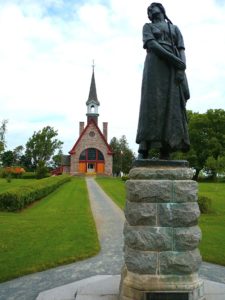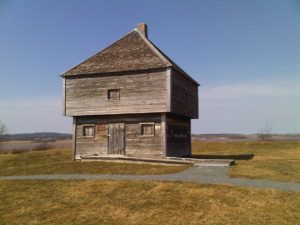In 1763, most of Acadia (Cape Breton Island, St. John’s Island (now Prince Edward Island), and New Brunswick) became part of Nova Scotia. In 1765, the county of Sunbury was created. This included the territory of present-day New Brunswick and eastern Maine as far as the Penobscot River. In 1769, St. John’s Island became a separate colony. Nova Scotia included present-day New Brunswick until that province’s establishment in 1784, after the arrival of United Empire Loyalists. In 1867, Nova Scotia became one of the four founding provinces of the Canadian Confederation.
17th and 18th Centuries:
The warfare on Nova Scotian soil during the 17th and 18th centuries significantly influenced the history of Nova Scotia. The Mi’kmaq had lived in Nova Scotia for centuries. The French arrived in 1604, and Catholic Mi’kmaq and Acadians formed the majority of the population of the colony for the next 150 years. During the first 80 years the French and Acadians lived in Nova Scotia, nine significant military clashes took place as the English and Scottish (later British), Dutch and French fought for possession of the area. These encounters happened at Port Royal, Saint John, Cap de Sable (present-day Port La Tour, Nova Scotia), Jemseg (1674 and 1758) and Baleine (1629). The Acadian Civil War took place from 1640 to 1645.

Beginning with King William’s War in 1688, six wars took place in Nova Scotia before the British defeated the French (and ultimately expelled much of their population) and made peace with the Mi’kmaq:
King William’s War (1688–1697),
Queen Anne’s War (1702–1713),
Father Rale’s War (1722–1725),
King George’s War (1744–1748),
Father Le Loutre’s War (1749–1755)
The Seven Years’ War, also called the French and Indian War (1754–1763)
The battles during these wars took place primarily Port Royal, Saint John, Canso, Chignecto, Dartmouth (1751), Lunenburg (1756) and Grand-Pré. Despite the British conquest of Acadia in 1710, Nova Scotia remained primarily occupied by Catholic Acadians and Mi’kmaq, who confined British forces to Annapolis and to Canso.
The Mi’kmaq signed a series of treaties with Great Britain, beginning after Father Rale’s War (1725). In 1725, the British signed a treaty (or “agreement”) with the Mi’kmaq, but the authorities have often disputed its definition of the rights of the Mi’kmaq to hunt and fish on their lands.

A generation later, Father Le Loutre’s War began when Edward Cornwallis arrived to establish Halifax with 13 transports on 21 June 1749. A General Court, made up of the governor and the Council, was the highest court in the colony at the time. Jonathan Belcher was sworn in as chief justice of the Nova Scotia Supreme Court on 21 October 1754. The first legislative assembly in Halifax, under the Governorship of Charles Lawrence, met on 2 October 1758. During the French and Indian War of 1754–63 (the North American theater of the Seven Years’ War of 1756–1763), the British deported the Acadians and recruited New England Planters to resettle the colony. The 75-year period of war ended with the Halifax Treaties between the British and the Mi’kmaq (1761). After the war, some Acadians were allowed to return and the British made treaties with the Mi’kmaq.
